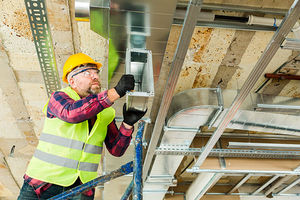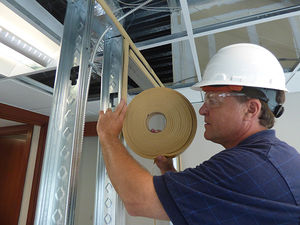Sustainable design has created many benefits and challenges to mechanical noise control efforts. From equipment selection to HVAC systems sound attenuation, these changes are influencing industry designs and acoustical outcomes. Engineers usually don’t have much control over building design decisions or architectural choices so they must adapt in order to meet noise goals and requirements. When engineers incorporate improved acoustic design into sustainability efforts, they can positively impact occupants while reducing energy consumption.
Dealing with Ducts
 Mechanical and architectural trends are driving a change for smaller areas being allocated for HVAC ducts and this has impacted HVAC noise generation. This squeeze reduces duct size which increases the velocity of the air in the ducts and consequently the noise. Sometimes natural ventilation is a design option also considered, but engineers should think about the resulting sound transmission and try to mitigate it using sustainable building materials. Noise can come in from outside the building or within the building and it can transfer sound from one space to another through ducts. Acoustically lined transfer ducts are a solution for these situations. Engineers and designers should also be conscious of HVAC system noise in spaces where speech privacy and disturbance reduction are important, like schools or healthcare facilities. While radiated noise can be reduced with duct insulation, heavier gauge duct, or high ceiling attenuation class lay-in ceiling panels, these treatments do not reduce duct-borne noise that invades spaces through the diffusers and inlets. Acoustical duct liner and wrap like ArmaFlex® Ultra and ArmaFlex FS®, are a sustainable and sound reduction strategy. Our fiber-free, closed-cell, thermal and acoustical insulation are engineered to attenuate HVAC noise, safeguard IAQ, and reduce energy loss when used to line or wrap HVAC ductwork.
Mechanical and architectural trends are driving a change for smaller areas being allocated for HVAC ducts and this has impacted HVAC noise generation. This squeeze reduces duct size which increases the velocity of the air in the ducts and consequently the noise. Sometimes natural ventilation is a design option also considered, but engineers should think about the resulting sound transmission and try to mitigate it using sustainable building materials. Noise can come in from outside the building or within the building and it can transfer sound from one space to another through ducts. Acoustically lined transfer ducts are a solution for these situations. Engineers and designers should also be conscious of HVAC system noise in spaces where speech privacy and disturbance reduction are important, like schools or healthcare facilities. While radiated noise can be reduced with duct insulation, heavier gauge duct, or high ceiling attenuation class lay-in ceiling panels, these treatments do not reduce duct-borne noise that invades spaces through the diffusers and inlets. Acoustical duct liner and wrap like ArmaFlex® Ultra and ArmaFlex FS®, are a sustainable and sound reduction strategy. Our fiber-free, closed-cell, thermal and acoustical insulation are engineered to attenuate HVAC noise, safeguard IAQ, and reduce energy loss when used to line or wrap HVAC ductwork.
Structuring Silence
 Noise travels through buildings quickly as sound vibrations get passed from one structural member (drywall, stud, floor, etc.) to the next. For decades builders have employed any number of methods to “decouple” or isolate noise in buildings, most notably by installing double sheets of drywall, resilient channel and isolation clips. But these options are costly, tedious and time consuming to install. Engineers and designers are now tasked with finding new and sustainable ways to prevent noise from disturbing occupants. ArmaComfort® MTD is a custom formulated elastomeric foam tape and an easy-to-install solution used to reduce the amount of structure-borne sound that can pass through partition walls. ArmaComfort MTD when applied directly to steel studs dramatically reduces pass through noise, increases the STC rating, and provides excellent sound transmission isolation at mid-level to high frequencies without thermal bridging. Architects can have confidence that ArmaComfort MTD meets ASTM E84 Class B and is UL classified/certified* for use in rated assemblies.
Noise travels through buildings quickly as sound vibrations get passed from one structural member (drywall, stud, floor, etc.) to the next. For decades builders have employed any number of methods to “decouple” or isolate noise in buildings, most notably by installing double sheets of drywall, resilient channel and isolation clips. But these options are costly, tedious and time consuming to install. Engineers and designers are now tasked with finding new and sustainable ways to prevent noise from disturbing occupants. ArmaComfort® MTD is a custom formulated elastomeric foam tape and an easy-to-install solution used to reduce the amount of structure-borne sound that can pass through partition walls. ArmaComfort MTD when applied directly to steel studs dramatically reduces pass through noise, increases the STC rating, and provides excellent sound transmission isolation at mid-level to high frequencies without thermal bridging. Architects can have confidence that ArmaComfort MTD meets ASTM E84 Class B and is UL classified/certified* for use in rated assemblies.
A Sustainable Future
Sustainable design initiatives overall have had a positive effect on building acoustics despite some of the challenges posed. From green credits, WELL Building standards and dedicated associations like ASHRAE, to improved legislative systems and certifying bodies, programs favoring design with noise control are driving the change in the building materials industry for the better. Possibly the biggest benefit has been the U.S. Green Building Council inclusion of a prerequisite and several elective credits for acoustics in their LEED® rating system. Prior to its inclusion, acoustics might have been of secondary importance or completely forgotten in sustainable design projects. Armacell is committed to sustainability and how our solutions can improve acoustic design, now and in the future.
For more acoustic sustainability ideas, please visit our acoustics solutions page here.
